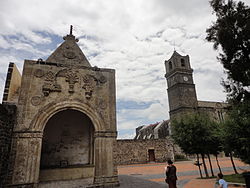Calpan | |
|---|---|
Municipality and town | |
 | |
 Location of the municipality in Puebla | |
| Country | |
| State | Puebla |
| Time zone | UTC-6 (Zona Centro) |
Calpan is a municipality in the Mexican state of Puebla. [1]
Calpan | |
|---|---|
Municipality and town | |
 | |
 Location of the municipality in Puebla | |
| Country | |
| State | Puebla |
| Time zone | UTC-6 (Zona Centro) |
Calpan is a municipality in the Mexican state of Puebla. [1]
Calpan was a Nahuatl-speaking community prior to the Spanish incursion. During the era of New Spain it was Corregidor of Atrisco. [2]